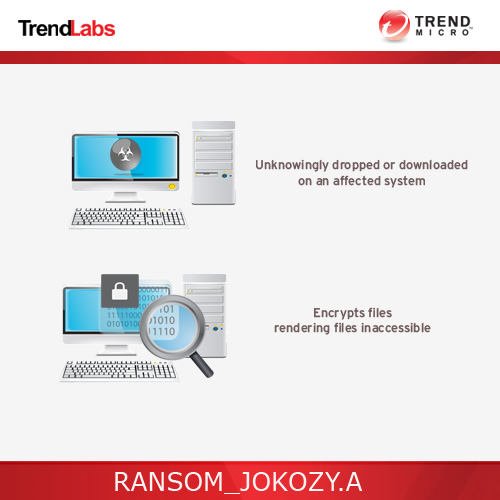RANSOM_JOKOZY.A
Trojan:Win32/Dynamer!ac (Microsoft); Ransom.KozyJozy (Malwarebytes); Trojan-Ransom.MSIL.Geograph.r (Kaspersky)
Windows


Threat Type: Trojan
Destructiveness: No
Encrypted:
In the wild: Yes
OVERVIEW
Downloaded from the Internet, Dropped by other malware
This ransomware has the ability to encrypt files found on an affected system. This routine makes these files inaccessible until a ransom is paid. Should the user not pay the ransom, the encrypted files will remain unusable. It is detected to use RSA 2048 asymmetric encryption to encrypt said files, making it impossible for the files to be decrypted without paying the ransom.
To get a one-glance comprehensive view of the behavior of this Trojan, refer to the Threat Diagram shown below.

This Trojan arrives on a system as a file dropped by other malware or as a file downloaded unknowingly by users when visiting malicious sites.
TECHNICAL DETAILS
143,872 bytes
EXE
Yes
21 Jun 2016
Drops files, Encrypts files
Arrival Details
This Trojan arrives on a system as a file dropped by other malware or as a file downloaded unknowingly by users when visiting malicious sites.
Installation
This Trojan drops the following component file(s):
- %User Profile%\w.jpg - ransom note

Other System Modifications
This Trojan adds the following registry entries:
HKEY_CURRENT_USER\SOFTWARE\Microsoft\
Windows\CurrentVersion\Run
wall = %User Profile%\w.jpg
Other Details
This Trojan encrypts files with the following extensions:
- .1cd
- .7z
- .accdb
- .arj
- .bmp
- .cd
- .cdr
- .dbf
- .doc
- .docx
- .epf
- .jpeg
- .jpg
- .ldf
- .max
- .md
- .mdb
- .mdf
- .odb
- .odg
- .ods
- .odt
- .png
- .ppt
- .pptx
- .psd
- .rar
- .rtf
- .tar
- .tif
- .xls
- .xlsx
- .zip
It renames encrypted files using the following names:
- {Original Filename}.31392E30362E32303136_{Key_ID}_LSBJ1
It does the following:
- It deletes shadow copies by executing the following command:
- vssadmin.exe Delete Shadows /All /Quiet
SOLUTION
9.800
12.604.08
21 Jun 2016
12.605.00
22 Jun 2016
Step 1
Before doing any scans, Windows XP, Windows Vista, and Windows 7 users must disable System Restore to allow full scanning of their computers.
Step 2
Note that not all files, folders, and registry keys and entries are installed on your computer during this malware's/spyware's/grayware's execution. This may be due to incomplete installation or other operating system conditions. If you do not find the same files/folders/registry information, please proceed to the next step.
Step 3
Delete this registry value
Important: Editing the Windows Registry incorrectly can lead to irreversible system malfunction. Please do this step only if you know how or you can ask assistance from your system administrator. Else, check this Microsoft article first before modifying your computer's registry.
- In HKEY_CURRENT_USER\SOFTWARE\Microsoft\Windows\CurrentVersion\Run
- wall = %User Profile%\w.jpg
- wall = %User Profile%\w.jpg
Step 4
Search and delete these files
- %User Profile%\w.jpg
Step 5
Scan your computer with your Trend Micro product to delete files detected as RANSOM_JOKOZY.A. If the detected files have already been cleaned, deleted, or quarantined by your Trend Micro product, no further step is required. You may opt to simply delete the quarantined files. Please check this Knowledge Base page for more information.
Step 6
Restore encrypted files from backup.
Did this description help? Tell us how we did.

